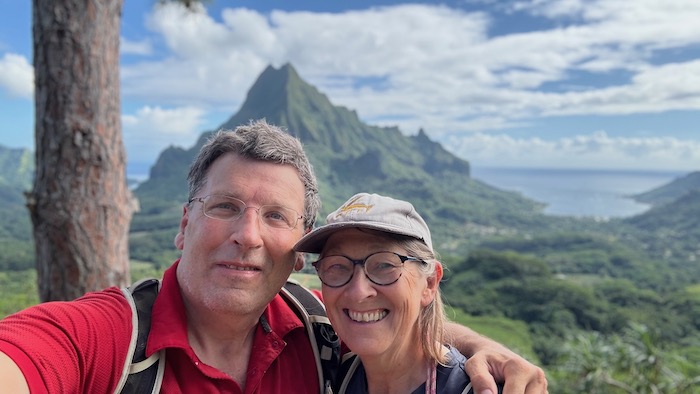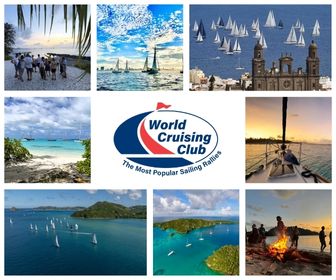INSIGHTS: SSB is Social Networking for Nostalgics
Despite the proliferation of satellite communications and digital WhatsApp groups in the cruising community these days, the decades-old radio communications technology of Single Sideband Radio – or SSB – is not yet dead and buried, as Ocean Cruising Club past Commodore Simon Currin found out while cruising in the South Pacific.
Published 10 hours ago, updated 2 hours ago
A Spark of Nostalgia
by Simon Currin – reprinted with permission
I love being connected to all things digital 24/7 and freely admit that I have a nerdy part of my brain that can be dismissive of analogue evangelists.
But this year something changed. The imminence of a significant birthday sparked a nostalgia for the early days of our ocean passage making. This coincided with our buddy boats all having rubbish VHF aerials, a crossing of paths with a passionate radio HAM and the existence of some terrific SSB nets a thousand miles away.
Single Sideband Radio, or SSB for short, is a high frequency, decades old, radio communication technology that’s powerful enough to span a hemisphere. Until the millennium it was the only way boats communicated when crossing oceans. Those that had it used SSB to get weather forecasts, report their positions and summon assistance when sinking. It worked most of the time – but it had its quirks and propagation of radio waves could be a bit too “hit and miss” for my liking. Nevertheless, we used it loads in the 1990s.
When we built Shimshal II we installed our old SSB radio from her predecessor, but it sat at our chart table both unloved and unused for two decades as satellite technology extinguished the need for old fashioned radio. Many, including me, have said that SSB is dead and cannot be resuscitated.


Then, on a lovely afternoon in Tonga, Mike called by in his dinghy and offered to test our SSB set in the hope that we might tune into an impromptu group of friendly cruisers all heading in the same direction. Mike is, perhaps, more nerdy than me – but embraces old technologies as well as the new. He measured the power our SSB sent to our backstay aerial and smiled at his findings. He then spent 90 minutes re-programming our set to make it almost analogue-idiot proof. How could we say no to joining his fledgling ‘Impromptu Net’?
0700Z?
My first problem was that the net was to be run at 0700Z – and I hadn’t a clue when that was – but it did sound awfully early for a notoriously late riser! Google helped by explaining that HAM radioists call UTC ‘Zulu time’ [Z] for reasons that remain unknown. So 0700Z translated into a much more acceptable 2000 local time.
I was so amazed that anyone heard me at all when I made my first, faltering SSB call in 20 years. Indeed, I was so shocked that I lost my powers of ‘radio-speech’. All that I had learned on a long range radio course in 2003 deserted me and I fluffed and jumbled my lines. For that transmission I was given the ‘dog’s breakfast’ award by the silky smooth net operator and took my rightful place at the bottom of the class.
Luckily, there was some stiff competition for the bottom of the class and soon I was joined by those who reported their position in decimals of a degree and those that mixed their SOGs with their COGs. The harder we tried the harder it became to string radio-fluent words together.
It didn’t matter. The background noise from radio waves bouncing off the ionosphere blurs the message and, in the days when analogue was all we had, clarity counted. But now a quick WhatsApp clears up a mis-spoken word and the muddled messages can easily be unscrambled by a glance at our digital gizmos that broadcast SOG and COG to giant public databases every minute of every day.
Old Style Social Network
What did matter is that we were communicating by voice in a time-honoured fashion across hundreds of miles of ocean. It was – unexpectedly – rather lovely. Human voices, wrapped in crackles and punctuated by weird, otherworldly, noises were bouncing from boat to boat with a little help from the the upper atmosphere and a mysterious thing called propagation. Magical. We had our own, old-style, social network,
As with all social media I quickly became re-addicted and, within a few days, I was reaching out for more with growing enthusiasm. I hooked into Gulf Harbour Radio in New Zealand and had nightly chats with Patricia and David who we hope to meet up with when we make it to Auckland. Patricia even complemented me on the strength of my signal!
Most enjoyable of them all was the ‘Broken VHF Net’ between us and our buddy boats with the wonky aerials. Being just over the horizon their signals came booming in and we all enjoyed the nightly chatter that is part of being human. We were proud that our own mini-net may not always have been in perfect radio-English!
SSB is Alive!
So SSB is not dead. It’s a wonderful social media for the nostalgics amongst us who value friendly voices mixed with a little static and a smattering of ionospheric distortion. We will be reaching out to our SSB equipped friends when we next cross an ocean.
Simon Currin
Past Commodore – Ocean Cruising Club
S/V Shimshal II
.………………………………
About the Author
Simon Currin has been cruising with his wife, Sally, since the mid-1990s. They launched their customized CR480DS cutter, Shimshal II in Sweden in 2006. After several seasons exploring Scandinavia, they returned to the Scottish Hebrides for five years before departing their home waters in 2015. They have spent time in Greenland as well as in the Canadian Maritimes and New England.
After Simon retired as a physician in 2021, they cruised through the Caribbean and in November 2023 they transited the Panama Canal, crossed the South Pacific and arrived in New Zealand in October 2025. Simon joined the Cruising Club of America in 2020 and was the commodore of the Ocean Cruising Club between 2019 and 2024. Sally is a former Treasurer of the same club.
Read more about their travels at:


.………………………………
About the Ocean Cruising Club
The Ocean Cruising Club is a gathering of sailors with vast amounts of miles under their keels and it has an extensive network of port officers worldwide.
.………………………………
About INSIGHTS
Insights is a platform where guest contributors from the sailing and cruising world share a variety of viewpoints on nautical and cruising-related topics ranging from how-to tutorials, equipment reviews, points of view, life on board, cruising concerns, voyaging with a conscience to simply cruising musings.
Insights was launched at the start of 2020 to celebrate Noonsite’s 20 years on the web and there are now many great articles for the Noonsite community to enjoy.
How to get involved with Insights
If you would like to be considered as a guest contributor, please contact editor@noonsite.com with a short summary of articles you have in mind and the word INSIGHTS in the subject line.
.………………………………
Find out all news, reports, links and comments posted on Noonsite, plus cruising information from around the world, by subscribing to our FREE monthly newsletter. Go to https://www.noonsite.com/newsletter/.
If you have found this information useful, become a paid member to enjoy unlimited use of Noonsite plus many other perks. Your membership fees really help our small, dedicated team keep country information up-to-date in support of cruisers worldwide. Find out more about Noonsite Membership levels and benefits here.
Related to the following Cruising Resources: Communications, Communications Equipment, General, Insights




